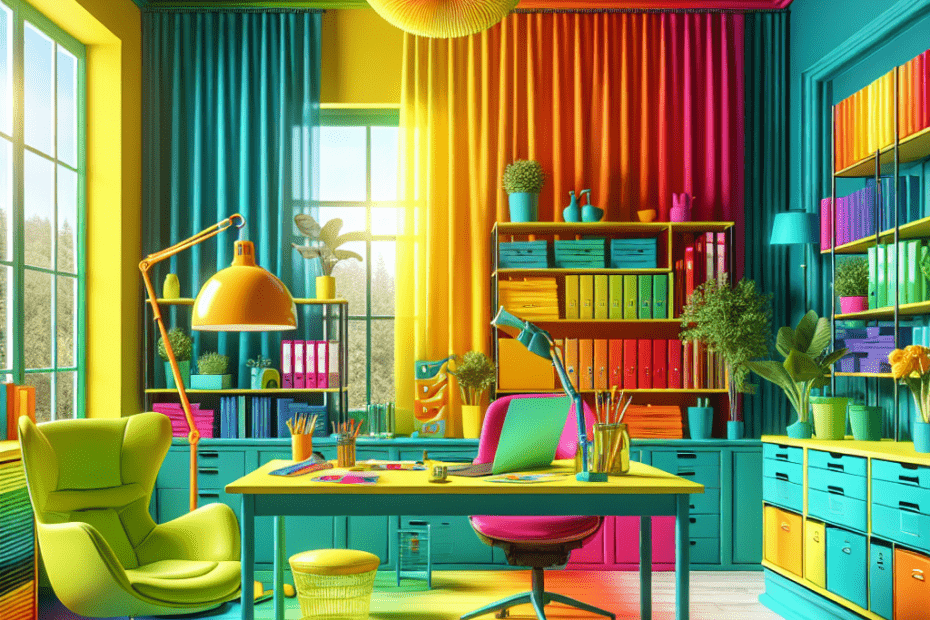“`html
Designing a Workspace with Bright Colors for Productivity
Many people spend a good portion of their day at work, and they understand more than ever the importance of a comfortable and motivating environment. Using bright colors in a workspace can improve productivity, according to studies on color psychology. By carefully planning out the colors and design of an office, they can create a workspace that not only looks inviting but also fuels creativity and efficiency.
The Psychology of Color
Color plays a crucial role in affecting mood and enhancing productivity. Research from the University of Texas found that certain colors can have varied impacts on individuals’ mood and behavior. For instance, bright colors like yellow and orange are known for energizing, while blue and green can help calm and promote concentration.
Additionally, a study by the Color Marketing Group found that colors can increase the amount of positive feelings within the workplace. Employees surrounded by bright and lively colors report a higher level of enthusiasm and productivity.
Choosing the Right Bright Colors for Your Workspace
When selecting bright colors for a workspace, it’s essential to consider the purpose of each area. For places where they wish to stimulate creativity, colors like bright red or orange could provide an energetic atmosphere. However, they should avoid using them excessively as they might lead to distractions due to overstimulation.
| Color | Effect |
|---|---|
| Yellow | Increases creativity and positivity |
| Red | Boosts energy and attention |
| Blue | Promotes calmness and concentration |
| Green | Enhances calmness and balance |
| Orange | Stimulates energy and enthusiasm |
Combining Bright Colors with Neutrals
While bright colors can offer a vibrant workspace, it is important not to overwhelm the senses. By balancing bright colors with neutral tones, they can maintain a comfortable harmony. For instance, brightly colored accent walls or furniture can be paired with soft gray or white to ensure the workspace remains professional yet stimulating.
Statistic Insights
According to a study by Lawton Color, 88% of people believe that positive color schemes help create a more productive working environment. Additionally, companies that incorporate color psychology into their office design have noted a 10% increase in productivity among their workforce.
Research from the International Productivity Platform suggests that small changes, such as altering the color scheme, can have significant impacts on overall job satisfaction and productivity.
Practical Tips for Using Bright Colors
- Accent Walls: They can consider painting one wall in a bright color to add a pop of energy without overwhelming the entire room.
- Bright Accessories: Incorporating colorful artwork or bright desk accessories can add splashes of color.
- Natural Light: They should allow natural light to highlight the colors, as it can enhance their appearance and positive effects.
- Color-Coded Areas: They can organize different sections with different colors to promote specific tasks or activities, like using green for a relaxation corner.
Key Takeaways
- Bright colors in a workspace can increase productivity and creativity.
- Different colors affect mood and behavior differently, requiring thoughtful selection.
- Balancing bright colors with neutral tones avoids overwhelming the senses.
- Statistics show a positive correlation between color use in office design and increased productivity.
FAQ
- Do bright colors always improve productivity?
Bright colors can enhance productivity when used correctly. However, overuse or inappropriate color choices might lead to distractions. - What is the effect of the color yellow in a workspace?
Yellow is known to boost creativity and positivity, but it should be used in moderation. - How can they use bright colors if a full makeover is not possible?
They can add colorful accessories or an accent wall to incorporate bright colors without a full makeover. - Should they use the same bright color throughout the workspace?
No, they should combine bright colors with neutrals and use varied colors for different areas to serve different purposes. - What colors should be avoided in a workspace?
Colors like black or overly dark shades might make a workspace feel dull and should be used sparingly.
“`
By using bright colors thoughtfully, they can transform their workspace into one that fosters both productivity and creativity, ultimately leading to more successful and satisfying work experiences.
